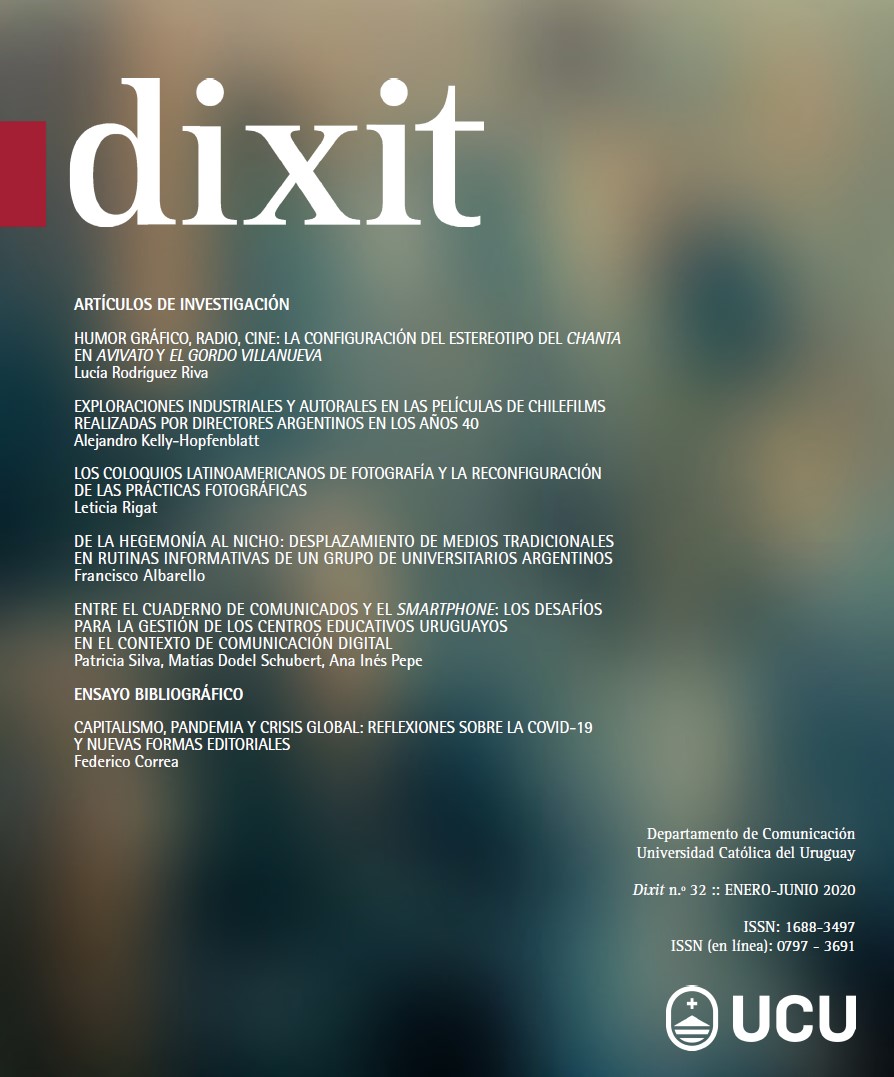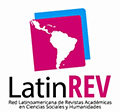Between the communication notebook and the smartphone. The challenges for the management in Uruguayan educational centers in the context of digital communication
DOI:
https://doi.org/10.22235/d.vi32.2118Keywords:
digital communication, communication skills, school, leadership, social inequalityAbstract
This article assesses how schools manage their communication with students' families. Schools face a challenge that combines the massive use of digital communication by families, considerable socioeconomic variance in their educational contexts, and a diversity of organizational policies and leadership styles. Based on a case study of a network of twelve private schools in Montevideo, we conducted semi-structured interviews with principals and teachers. Our findings indicate that, despite the massification of digital devices, principals and teachers continue to express preferences for traditional non-digital channels of communication, for the majority of school-related topics. Even without an explicit rejection of digital technologies, respondents manifest diverse barriers that prevent their implementation. Recommendations are provided for rethinking communication based on organizational strategies.
Downloads
References
Aragonés, J. P. (2001). La competencia comunicativa en el entorno tecnológico: desafío para la enseñanza. Comunicar, (17), 21-30.
Banco Interamericano de Desarrollo. (2019). Del papel a la nube: Cómo guiar la transformación digital de los Sistemas de Información y Gestión Educativa (SIGED). Recuperado de: https://publications.iadb.org/es/del-papel-la-nube-como-guiar-la-transformacion-digital-de-los-sistemas-de-informacion-y-gestion
Banco Interamericano de Desarrollo. (2020). La educación en tiempos del coronavirus: Los sistemas educativos de América Latina y el Caribe ante COVID-19. Recuperado de https://publications.iadb.org/es/la-educacion-en-tiempos-del-coronavirus-los-sistemas-educativos-de-america-latina-y-el-caribe-ante-covid-19
Beauchamp, L., y Parsons, J. (2014). Liderazgo instructivo en Alberta: Hallazgos de la investigación en cinco escuelas altamente eficaces. REICE: Revista Iberoamericana sobre Calidad, Eficacia y Cambio en Educación, 12(4), 89-98.
Bochaca, J. G. (2015). La comunicación familia-escuela en educación infantil y primaria. Revista de Sociología de la Educación-RASE, 8(1), 71-85.
Bordalba, M. M. (2016). La comunicación familia-escuela: el uso de las TIC en los centros de primaria. Revista electrónica interuniversitaria de formación del profesorado, 19(1), 73-83.
Bouhnik, D., Deshen, M., y Gan, R. (2014). WhatsApp goes to school: Mobile instant messaging between teachers and students. Journal of Information Technology Education: Research, 13(1), 217-231.
Bush, T. (2007). Educational leadership and management: Theory, policy and practice. South African journal of education, 27(3), 391-406.
Calvo, J. J. (Coord.). (2013). Atlas sociodemográfico y de la desigualdad del Uruguay. Fascículo 1: Las necesidades básicas insatisfechas a partir de los Censos 2011. Recuperado de http://www.ine.gub.uy/documents/10181/34017/Atlas_fasciculo_1_NBI_versionrevisada.pdf/57ea17f9-3fd9-4306-b9ca-948abc7fab73
Cox, D., y McLeod, S. (2014). Social media strategies for school principals. NASSP Bulletin, 98(1), 5-25.
Engen, B. K. (2019). Comprendiendo los aspectos culturales y sociales de las competencias digitales docentes. Comunicar: Revista científica iberoamericana de comunicación y educación, (61), 9-19.
El Nokali, N. E., Bachman, H. J., y Votruba‐Drzal, E. (2010). Parent involvement and children’s academic and social development in elementary school. Child development, 81(3), 988-1005.
Epstein, J. L. (1985). Home and school connections in schools of the future: Implications of research on parent involvement. Peabody Journal of Education, 62(2), 18-41.
Epstein, J. L. (1995). School/family/community partnerships. Phi delta kappan, 76(9), 701.
Epstein, J. L. (2013). Preocupándonos por los niños que compartimos. En Programas efectivos de
involucramiento familiar en las escuelas: estudios y prácticas (pp.15-50). Recuperado de http://www.upla.cl/noticias/wp-content/uploads/2015/09/capitulos_-seleccionados_joyce_epstein.pdf
Ersöz, S. (2019). Understanding WhatsApp Parent Group’s Dynamics: Group Communication and Information Sharing. Manas Sosyal Araştırmalar Dergisi, 8(1), 1167-1183.
Forero, C. P. S. (2011). Estado del arte de la nueva comunicación estratégica en Iberoamérica y Colombia. Signo y Pensamiento, 31(59), 234-346.
Fraillon, J., Ainley, J., Schulz, W., Friedman, T., y Duckworth, D. (2019). Preparing for life in a digital world: the IEA International Computer and Information Literacy Study 2018 International Report. Recuperado de https://www.iea.nl/sites/default/files/2019-11/ICILS%202019%20Digital%20final%2004112019.pdf
Goodall, J. S. (2016). Technology and school–home communication. International Journal of Pedagogies and Learning, 11(2), 118-131.
Gore, E. (2004). La educación en la empresa: Aprendiendo en contextos organizativos (3ª ed). Buenos Aires, Argentina: Granica.
Guardia Romero, R. M. D. L., y Santana Armas, F. (2010). Alternativas de mejora de la participación educativa de las familias como instrumento para la calidad educativa. REICE: Revista Electrónica Iberoamericana Sobre Calidad, Eficacia y Cambio En Educación, 8(3), 6-30.
Hernández, I. M., Martínez, A. C., y Vicente, M. A. G. (2017). Grupos de WhatsApp en familias de Educación Infantil y Primaria. RELATEC: Revista Latinoamericana de Tecnología Educativa, 16(2), 239-255.
Hodas, S. (1996). Technology refusal and the organizational culture of schools. Computerization and controversy: Value conflicts and social choices, 2, 197-218.
Hohlfeld, T. N., Ritzhaupt, A. D., y Barron, A. E. (2010). Connecting schools, community, and family with ICT: Four-year trends related to school level and SES of public schools in Florida. Computers & Education, 55(1), 391-405.
Huang, R. H., Liu, D. J., Tlili, A., Yang, J. F., y Wang, H. H. (2020). Handbook on Facilitating Flexible Learning During Educational Disruption: The Chinese Experience in Maintaining Undisrupted Learning in COVID-19 Outbreak. Beijing, China: Smart Learning Institute of Beijing Normal University.
LaRocque, M., Kleiman, I., y Darling, S. M. (2011). Parental involvement: The missing link in school achievement. Preventing School Failure, 55(3), 115-122.
Lingam, G., Lingam, N., y Raghuwaiya, K. (2014). Effectiveness of school strategic planning: The case of Fijian Schools. International Journal of Social, Behavioral, Educational, Economic, Business and Industrial Engineering, 8(7), 2110-2116.
Mayo, I. C., y García, A. M. (2012). La comunicación en los centros educativos: un estudio de caso. Tendencias pedagógicas, (19), 107-130.
Noblía, V. (2018). La interacción laboral en redes sociales móviles. El uso de los modos como estrategia de atenuación. Círculo de Lingüística Aplicada a la Comunicación, 73, 77-102.
Odhiambo, G., y Hii, A. (2012). Key stakeholders' perceptions of effective school leadership. Educational Management Administration & Leadership, 40(2), 232-247.
Olmstead, C. (2013). Using technology to increase parent involvement in schools. TechTrends, 57(6), 28-37.
Peña-López, I. (2009). Measuring digital development for policy-making: Models, stages, characteristics and causes (Tesis de Doctorado). Internet Interdisciplinary Institute, Universitat Oberta de Catalunya, Barcelona, España.
Pieri, M. (2018). Le relazioni scuola / famiglia in Italy: una ricerca in un Istituto Comprensivo dell'Emilia-Romagna. Annali en línea della Didattica e della Formazione Docente, 10(15-16), 464-478.
Reimers, F. M., y Schleicher, A. (2020). A framework to guide an education response to the COVID-19 Pandemic of 2020. Recuperado de https://www.hm.ee/sites/default/files/framework_guide_v1_002_harward.pdf
Robinson, L., Cotten, S. R., Ono, H., Quan-Haase, A., Mesch, G., Chen, W., ... Stern, M. J. (2015). Digital inequalities and why they matter. Information, communication & society, 18(5), 569-582.
Walther, J. B. (1996). Computer-mediated communication: Impersonal, interpersonal, and hyperpersonal interaction. Communication research, 23(1), 3-43.
Walther, J. B. (2011). Theories of computer-mediated communication and interpersonal relations. The handbook of interpersonal communication, 4, 443-479.
Wang, G., Zhang, Y., Zhao, J., Zhang, J., y Jiang, F. (2020). Mitigate the effects of home confinement on children during the COVID-19 outbreak. The Lancet, 395(10228), 945-947.
Wasserman, E., y Zwebner, Y. (2017). Communication between teachers and parents using the WhatsApp application. International Journal of Learning, Teaching and Educational Research, 16(12). https://doi.org/10.26803/ijlter.16.12.1
Wellman, B., Quan-Haase, A., Boase, J., Chen, W., Hampton, K., Díaz, I., y Miyata, K. (2003). The social affordances of the Internet for networked individualism. Journal of computer-mediated communication, 8(3), JCMC834.
Wellman, B., y Hogan, B. (2004). The immanent internet. En J. McKay (ed.), Netting citizens: Exploring citizenship in a digital age (pp. 54-80). Edimburgo, Escocia: St. Andrews Press.
Downloads
Published
How to Cite
Issue
Section
License
From issue number 32 onwards all contents are licensed under the Creative Commons Attribution 4.0 International License (CC BY 4.0).
Issues number 29-31 are licensed under the Creative Commons Attribution-NonCommercial 4.0 International License.
The contents corresponding to number 28 and earlier editions are under the Creative Commons Attribution-NonCommercial-ShareAlike 4.0 International License.


















